Вы здесь
KBTU building in Almaty.
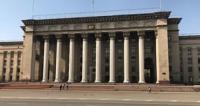
Tours to monuments of history and culture of Almaty.
“All the more spectacularly, all of a sudden, all over the wide expanse of the newly founded fortification, the cheerful multi-colored lights of the illumination lit that day appeared to me completely unexpectedly, which presented me with Vernoye in a completely enchanting form. I knew that houses in Verny, except for the hastily built house of the bailiff of the Great Horde, did not yet exist, and meanwhile, shiny multi-colored scales indicated the beautiful facades of many of these non-existent houses”.
Pyotr Semenov Tyan-Shansky. "Heavenly herebet and the Zali region". 1855
List of historical and cultural monuments in Almaty.
The former building of the Government House is located in the central part of the city, in the square between Abylai Khan Avenue on the east side, Panfilov Street on the west side, Tole bi on the south side, Kazybek bi on the north side.
The main facade of the former building of the House of Government faces south, in front of which there is a square (official names in different years: the name of Lenin, Astana, but after the appearance of the New Square along Satpaev Street, the name Staraya was assigned to it, which is the most common among the townspeople).
Mass events are held on this square. From the north, west and east of the Government House there are squares with fountains. The foundation pit for the construction of the largest structure in Soviet Alma-Ata was dug shortly after the approval of the project in 1933.
But the construction was delayed for subjective and objective reasons, and until 1951 there was a big hole in the city center - a favorite place for local boys. Old-timers recall that during the war the foundation pit was used by the United Film Studio (TsOKS) for location filming of war films.
On the surviving sketch, you can see the Government House in the form in which the designers intended it: “Inclusion in the composition of a high-rise element in the form of a helmet-shaped dome on a drum and sculptural groups on the Soviet theme greatly enriches both the silhouette of the building and its ideological and artistic image.”
However, due to a lack of funding, neither the "drum with a dome" nor the "thematic groups that enrich the silhouette" survived in the original.
This is how the project of the new Government House of the Kazakh SSR is described in the book by Mendikulov M. M. “Architecture of the city of Alma-Ata”. Alma-Ata, 1953:
“The project for a new building of the House of the Government of the Republic was drawn up as early as 1933, but due to the Great Patriotic War, its construction was not started. According to the original project, the building had an architectural solution in creatively reworked forms of classical architecture.
And only in 1951, according to a revised project, the construction of this largest building in Alma-Ata began, which will soon become the organizing center of the architectural and planning composition of the entire city.
The planned building of the Government House (volume 108,600 cubic meters) houses the Council of Ministers, the CPC Central Committee and the Supreme Council of the Republic. The planned solution of the building fully corresponds to its internal content and provides for each of the indicated government institutions a separate building with a plenum hall uniting them in the center of the composition.
The front building, located along the main facade, is allocated for the complex of premises of the CPC Central Committee, in the right, eastern building, overlooking the side of Panfilov Street, the Supreme Council is located, in the western building, which faces Stalin Avenue, - the Council of Ministers.
In the center of these three buildings, the plenum hall is located in such a way that together with them it forms two large courtyards, and its entrance group protrudes as a separate volume on the northern facade with a six-columned portico.
These large courtyards have through ventilation, corner passages and meet the climatic conditions of the area. A group of utility rooms serving all these three institutions is located mainly on the lower floors of the building.
All the main premises of the building - the plenum hall, the meeting rooms of the Council of Ministers, the Supreme Council and the Central Committee of the CPC, offices and executive reception rooms have a clear layout and good proportions, provided with sufficient daylight.
The compact three-dimensional composition of the building, built on the basis of the order system of classical architecture, creates a monumental image of this large public building. The inclusion in the composition of a high-rise element in the form of a helmet-shaped dome on a high drum and sculptural groups on the Soviet theme greatly enriches both the silhouettes of the building and its ideological and artistic image.
All facades, worked out in solemn forms, are organically linked to each other and form a harmonious whole. In the architectural design of this building, the search for national forms is based on a synthesis of the methods and forms of Russian classical architecture with progressive elements of national architecture.
The thoughtful attitude of the authors to the use of the traditions of national architecture can be seen not only in the meaningful use of stylistic forms and details, but also in the planned design of the building, which provides for the creation of shaded and ventilated courtyards, the installation of air colonnades, green spaces and fountains.
In addition, the skillful use of favorite motifs of folk ornament enhances the national character of the architecture of the building. However, for all its merits, the work in question is not without some shortcomings. First of all, one should point out the fundamental drawback, which is the mixing of forms of different styles.
So, for example, in the national interpretation of the decision of the external architecture of the building in the design of the plenum hall, the Ionic order of classical architecture with all its inherent elements is used.
This is not only a violation of the unity of the external and internal architecture of the building, but also an element of eclecticism. The weak point of the composition of the main façade is the lightness of the pylons (antes) flanking the colonnade of the main portico; I would like to see them more massive.
In addition, there is not enough contrasting background for the main facade - a blank plane used in national architecture as a compositional element. The unraveled frieze was left smooth; it would be desirable to place bas-reliefs on modern themes here, which would greatly enrich the ideological and artistic image of the structure.
Such unfortunate forms are striking, such as a horizontal insert between the windows of the fourth and fifth floors, which has a different character of study and is knocked out of the general system of designing wall planes.
The high-rise part of the building - the dome above the plenum hall, did not receive a convincing solution, the transition from the high drum to the helmet-shaped dome is not architecturally distinguished, it is masked by vertical elements that are rather strange in silhouette, which do not at all harmonize with the strict appearance of the building.
The dome itself has a sluggish and inexpressive form and ends with an undrawn spire. In the decorative design of the facades, the nature of the ornaments has not been revealed, while they are given only hints. Structurally, the building is a reinforced concrete frame filled with porous bricks and lined with noble finishing materials, in particular, local varieties of granites and marbles will be used for facade cladding.
In general, it should be noted with great satisfaction that the project of the new building of the Government House under construction in terms of the architectural and planning part was developed at a high ideological and artistic level, the architecture of the building was decided by the creative use of the heritage of national architecture and ornamental art of Kazakhstan.
The architectural and artistic means used by the authors of the project quite convincingly reveal the image of a Soviet public building.”
Construction of the building began in 1938. The financial side of the project was about 14,000,000 rubles. By 1941, only the foundation pit had been prepared. During the war, construction was suspended. It resumed only in 1951.
The design was carried out by the Mosproekt workshop. The project was led by the architect B. R. Rubanenko. Technical drawings were made by the architects of Kazgosproekt under the direction of P. A. Mamontov and G. A. Kalish.
Construction was completed in 1957. The former Government House of the Kazakh SSR is a 5-storey building, rectangular in plan, placed on a high pedestal. In 1972, the building was reconstructed - two wings were added - reworked forms of national architecture and folk art motifs.
The landscaping of the square on the north side was carried out according to the project of V. Dreiman - a continuous strip of flowers with eight small fountains along the axis of the building. A construction project was also considered, on the north side of the reservoir building with an area of 3200 square meters, which reflected the facade.
Until 1980, the building housed the Central Committee of the Communist Party of the Kazakh SSR. In 1980, the Central Committee of the Communist Party moved to a building on New Square (now Republic Square).
In 1998 - 2001 The building housed the akimat of the Almaty region. Since 2001, the building has housed the Kazakh-British Technical University - a university that trains professional personnel for the oil and gas, information, and financial sectors.
The University was established by the Decree of the Government of the Republic of Kazakhstan dated August 3, 2001. The building of KBTU - the former Government House is included in the state list of historical and cultural monuments of republican significance under No. 10.
Geographical coordinates of the KBTU former Government House building: N43°15'20.02" E76°56'35.28"
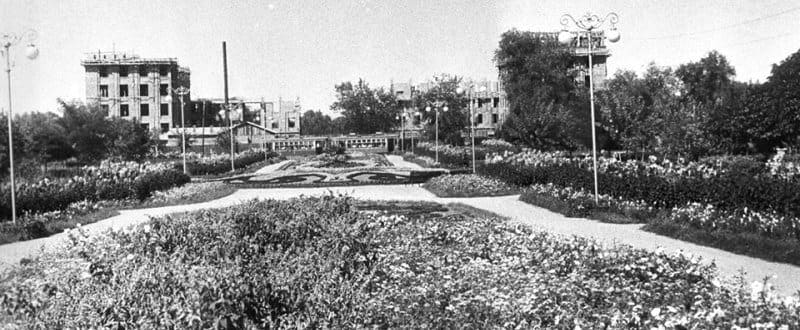
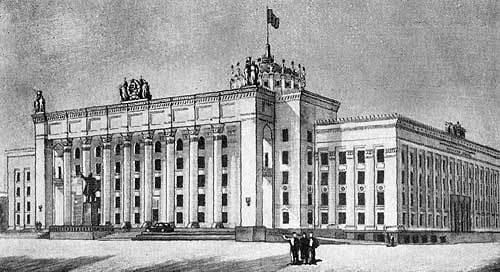
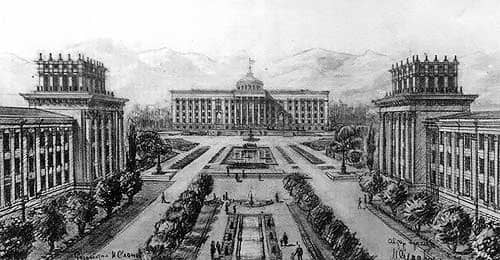
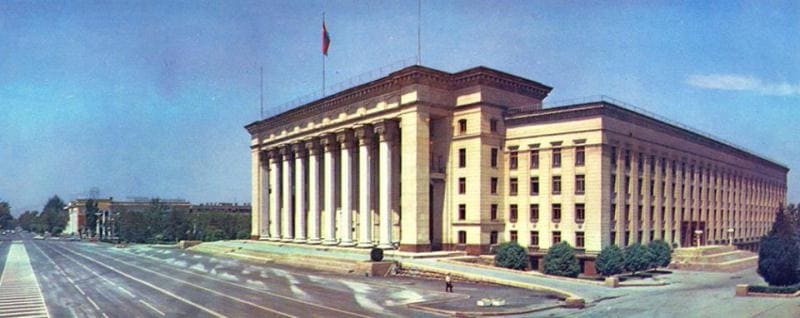
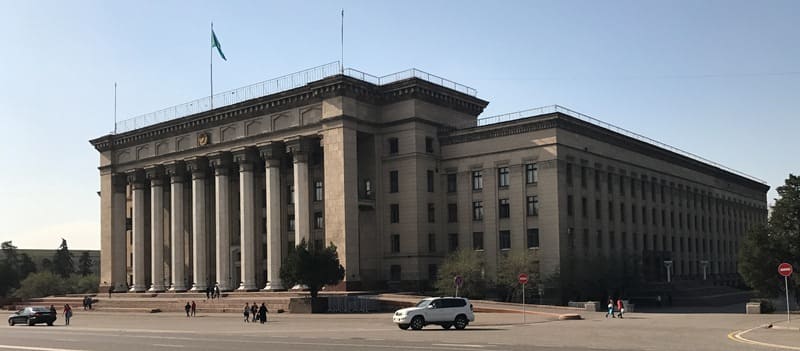
Authority and photos by:
Vladimir Proskurin. http://dostoprim.almaty.kz/
Literature:
Matveeva L. The building of the Academy of Sciences of the Republic of Kazakhstan.- In the book. : Monuments of history and culture of Almaty. Catalog of documents of the Department of Archives and Documentation and the Central State Administration of Almaty.-Almaty, publishing house "Oner", 2003, pp. 81 - 82.
Malinovskaya E.G. Academy of Sciences of Kazakhstan. In book. : Code of monuments of history and culture of the city of Almaty. - Almaty, LLP "Kazakh Encyclopedia", 2006, p.220 - 222 (appearance illustration).







